英语句子种类讲解
英语中句子的种类

三句子的种类句子是一个独立的语言单位,表示一个完整的思想.按使用目的可分为陈述句、感叹句、疑问句和祈使句;从结构上又可分为简单句、并列句和复合句.按使用目的分:一、陈述句That boy always helps others.Tom was not at home yesterday.He is too late to catch the bus.二、疑问句一般疑问句、特殊疑问句、选择疑问句和反意疑问句Are you a doctorHow often do you have an English partyWhich would you like better, tea or coffeeShe is too young to go to school, is she三、感叹句(一)What +a /an+形容词+可数名词的单数形式+主语+谓语 ==二How+形容词+a/an +可数名词的单数形式+主语+谓语What a beautiful girl she is == How beautiful a girl she is三 What+形容词+可数名词的复数+主语+谓语What beautiful girls they are(四)What+形容词+不可数名词+主语+谓语What fine weather it is(五)How+形容词或副词+主语+谓语How interesting the dog is(六)How+主语+谓语How time flies四、祈使句祈使句主语通常被省略,谓语动词用原型.Be quietDon’t be late从结构上分:一、简单句句子只包含一个主谓结构.如,五种基本句型列式如下:基本句型一:主+系+表基本句型二:主+谓基本句型三:主+谓+宾基本句型四:主+谓+间宾+直宾基本句型五主+谓+宾+宾补.二、并列句句子包含两个或多个主谓结构,通常有并列连词连结.由并列连词把两个或两个以上的简单句连在一起的句子叫并列句.不同的并列连词表示并列分句之间的不同关系.根据并列分句之间的关系不同,并列句可以分为以下几种: 1.表示联合关系的并列句这类并列句常用并列连词and 和,not only ... but also... 不但……而且……等来连接,这时分句之间是顺承关系或并列关系.and一般不译出来.1. We bought her a birthday present,_____ she liked it very much.A. soB. orC. andD. but2. — Didn’t you give roses to your father on Father’s Day— Oh, not only my father,_____ my grandpa got red roses.A. orB. andC. butD. until2.表示转折关系的并列句这类并列句常用but 但是;可是,yet可是;然而,while 而等来连接,后面分句与前面分句之间有意义上的转折关系.1. — Would you like to go to the concert with me— I’d love to,_____ I can’t. I have a lot of homework to do.A. orB. butC. soD. and2. The doctors tried their best to save the patient’s life,_____ failedA. orB. soC. butD. because3.表示选择关系的并列句这类并列句常用并列连词or或者,either …or …要么……,要么……等连接.1. _____ Lily _____ Lucy may go with you because one of them must stay at home.A. Not only; but alsoB. Neither; norC. Both; andD. Either; or2. None of the shoes in the shops are the right size. They are _____ too big _____ too small.A. both; andB. neither; norC. either; orD. not only; but also3. “Are you going to eat here ____ take it away” asked the waiter..A. andB. soC. orD. but.4.表示因果关系的并列句这类并列句常用并列连词so因此;所以,for 因为等连接,后面分句与前面分句之间有因果关系.1. Mother was ill,_____ Father cooked for us instead.A. butB. orC. soD. and2. There is a lot of traffic in this city,_____ look both waysbefore crossing the streetA. soB. andC. butD. for特殊的并列句1.祈使句+and+一般将来时的句子这个句型表示“如果做到了祈使句表示的事情,就会有后面句子表示的结果”.2.例如: Study hard,_____ you are sure to have a good resultin the exam.A. orB. andC. forD. but3. 2. 祈使句 + or + 一般将来时的句子这个句型表示“如果做不到祈使句表示的事情,就会有后面句子表示的结果”4.例如: 1. Be quick,_____ we’ll be late for class.A. orB. soC. andD. but2. Come a little earlier next time,_____ you’ll miss thebest part of the TV play.A. andB. butC. orD. till三、复合句复合句Complex Sentence由一个主句Principal Clause和一个或一个以上的从句Subordinate Clause构成. 主句是全句的主体,通常可以独立存在;从句则是一个句子成分,不能独立存在.从句不能单独成句,但它也有主语部分和谓语部分,就像一个句子一样.所不同在于,从句须由一个关联词引导. 我们至今学过的从句有:定语从句, 名词性从句主语从句、宾语从句、表语从句、同位语从句,和状语从句.1. 定语从句 He is the man who wants to see you.2. 同位语从句 She told us her hope that she would become a pianist.注意:定语和同位语从句的区别.3. 表语从句 This is what we should do4. 宾语从句注意it做形式宾语Everybody knows that money doesn't grow on treesWe think it wrong that he told a lie to everyone. it做形式宾语5.主语从句注意it做形式主语What caused the accident remains unknownIt is certain that he will win the matchit做形式主语6.状语从句MyfriendsdislikemebecauseI’mhandsomeandsuccessfu l.。
英语四大句子种类

英语四大句子种类英语四大句子种类指的是英语语法中常见的四种句子类型,它们分别是:简单句、并列句、复合句和复杂句。
这四种句子类型在英语语法中占据着重要的地位,它们在结构和表达意思上都有各自的特点。
下面将对这四种句子类型进行详细的介绍和举例说明。
●简单句 (Simple Sentences)●简单句是指只有一个主语和一个谓语的句子。
这种句子结构简单,表达的意思也较为简单。
例如:●She sings beautifully. (她唱得很美。
)●He loves football. (他喜欢足球。
)●这些句子只有一个主语和一个谓语,因此它们是简单句。
并列句 (Compound Sentences)并列句是指由两个或两个以上的简单句组合而成的句子。
这种句子通过使用并列连词(如and、but、or等)将简单句连接在一起。
例如:●I like coffee and she likes tea. (我喜欢咖啡,她喜欢茶。
)●He is smart but he is lazy. (他很聪明但是很懒。
)●这些句子都是由两个简单句组合而成的,因此它们是并列句。
复合句 (Complex Sentences)复合句是指由一个主句和一个或多个从句组成的句子。
这种句子通常包含一个主语和一个谓语,以及一个或多个从句作为补充信息。
例如:●She believes that he is honest. (她相信他是诚实的。
)●They were surprised when the door opened. (门打开时他们感到惊讶。
)●这些句子都包含一个主句和一个或多个从句,因此它们是复合句。
复杂句 (Compound-Complex Sentences)复杂句是指由一个主句和两个或多个从句组成的句子。
这种句子通常包含一个主语和一个谓语,以及两个或多个从句作为补充信息。
例如:●We know that she is a good student, although she is often late forschool. (我们知道她是一个好学生,尽管她经常上学迟到。
英语句子按功能分类讲解
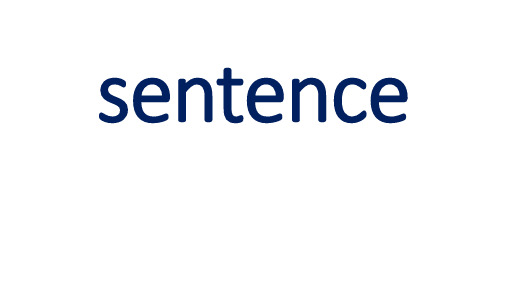
4.主语+动词原形…。如: Tom.you go and see what’S happening. 汤姆,去看看发生什么事情了。 You,girls,clean the desk;you,boys,sweep the floor. 你们,女生擦桌子。你们,男生,打扫地板。
5.祈使句+and/or+陈述句(and表示顺承关系,or表示 转折 关系)。如: ①use your head,and you’11 find a good way.(=If you use your head,you’11 find a good way.)动动脑 筋,你会找到一种好办法的。 ②Hurry up,or we’11 be late.(=If we don’t hurry up, we’11 be late.)快点,不然我们就迟到了。
“what+名词+主语+谓语……!”
(1)What +a(an)+(形容词)+单数可数 名词+主语+谓语! eg.What a cold day it is today! (2)What+(形容词)+复数可数名词+……! eg.What heavy boxes they are! 3)What+(形容词)+不可数名词+……! eg.What delicious ice-cream it is!
• 感叹句记忆口诀 感叹句,并不难,what与how应在前。 形容词、副词跟着how,what后面名词连。 名词若是可数单,前带冠词a或an。 主语、谓语放后面,省略它们也常见。
祈使句的判定和特点
祈使句用来表达说话人的请求、命令、建议、劝告等。 谓语动词用动词原形。其主语是you,往往省略。 常见的祈使句句型如下: 1.动词原形…如: ①Lay down your arms! ②Be sure to get there before eight O’clock
英语语法-句子的种类(史上最详细)

(4) 现在完成时和过去完成时的一般疑问句。 将助动词 have/has /had提至句首。 You have known her since your childhood? Have you known her since your childhood? 你从童年时就认识她吗? Yes I have /No I haven’t He had learned English before he came here? Had he learned English before he came here? 他来这之前就学过英语吗? Yes he had / No he hadn’t.
2.感叹句的种类
感叹句一般用what 或how开头,其具体用法如下:
(1) what引导的感叹句 (中心词是名词)
①What +a/an+ 形容词+可数名词单数(+主语+谓语)!
What a cold day (it is) !
多么冷的一天啊!
What a clever boy (he is)! 多么聪明的男孩!
句子的种类
英语的句子按照用途可分为四类:陈述句、疑问句、祈使 句和感叹句。
(一)陈述句
用来陈述一件事实或表达说话者看法的句子叫作陈述句, 句末用句号表示句子的陈述结束。陈述句分为肯定句和否 定句。 I like apples. 我喜欢苹果。 Tom is not good at English. 汤姆英语学得不好。
(2) 情态动词的一般疑问句。 陈述句中有情态动词,直接将情态动词提至主语前。 You can bring me some bread. Can you bring me some bread? Yes I can / No I can’t I must do it now. Must I do it now? Yes you must / No you need not.
英语句子成分讲解及句子类型课件

取得英语语法成功的基石
202X
个人报告总结模板
Parts of Speach
词类
作 用
例 词
1. (n.)名 词
表示人或事物的名称。
I bought a book . She is a student.
2. (pron.)代词
代替名词、数词等。
This is my friend. He likes that book because it is very useful to him.
二、宾语 宾语可以用下面这些东西表示: 1.She lived a happy life.( ) 2.I love you.( ) 3.We need two.( ) 4.Do you mind my opening the door?( ) 5.He began to learn English a year ago.( ) 6.He did not know what to say.( ) 7.Did you write down what she said? ( ) 8. She felt it her duty to take good care of them. ( )
There are ten apples on the table and I will take the first one.
5. (v.)动 词
表示动作或状态。
We are working hard at English. I want to become an engineer.
6. (adv.)副 词
△双宾语:指人的是间接宾语,指物的是直接宾语。 He gave me two books.
及物动词
介词
英语句子种类

My deskmate often makes me laugh.
常见的可接不带to不定式当宾补的动词有: 一感二听三让五看” feel,/ hear, listen to, / let, make, have, /look at, see, , watch, notice, observe V + O + OC (V sb do sth)
英语句子基本成分示意图
宾语 宾语 宾补 宾语(间) 宾语(直) Vi(不及物动词)
表语
系动词
I like the golden eagle.
It has a hooked beak.
It looks strong.
It is lovely.
S
S
S
S
V
V
linking verbs(系动词)
for, so, therefore, thus
or, otherwise, either…or
练习:用适当的连词填空
1.August is the time of the year for harvesting , ________every day I work from dawn until dark. 2.He is a basketball fan,____ his wife is a volleyball fan. 3.Honey is sweet,_____ the bee stings. 4.Don’t be late, ______there is a meeting. 5.Hurry up, ____you’ll be late. 6.He works hard ______his brother is a lazy bone. 7.He was enjoying his KFC _____ a friend came.
句子的种类英语基础语法汇总
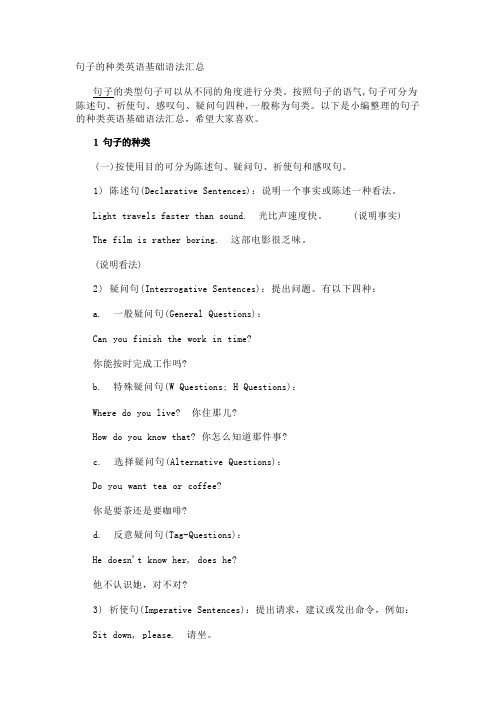
句子的种类英语基础语法汇总句子的类型句子可以从不同的角度进行分类。
按照句子的语气,句子可分为陈述句、祈使句、感叹句、疑问句四种,一般称为句类。
以下是小编整理的句子的种类英语基础语法汇总,希望大家喜欢。
(一)按使用目的可分为陈述句、疑问句、祈使句和感叹句。
1) 陈述句(Declarative Sentences):说明一个事实或陈述一种看法。
Light travels faster than sound. 光比声速度快。
(说明事实)The film is rather boring. 这部电影很乏味。
(说明看法)2) 疑问句(Interrogative Sentences):提出问题。
有以下四种:a. 一般疑问句(General Questions):Can you finish the work in time?你能按时完成工作吗?b. 特殊疑问句(W Questions; H Questions):Where do you live? 你住那儿?How do you know that? 你怎么知道那件事?c. 选择疑问句(Alternative Questions):Do you want tea or coffee?你是要茶还是要咖啡?d. 反意疑问句(Tag-Questions):He doesn't know her, does he?他不认识她,对不对?3) 祈使句(Imperative Sentences):提出请求,建议或发出命令,例如:Sit down, please. 请坐。
Don't be nervous! 别紧张!4) 感叹句(Exclamatory Sentences):表示说话人惊奇、喜悦、愤怒等情绪,例如:What good news it is! 多好的消息啊!(二)句子按其结构可以分为以下三类:1) 简单句(Simple Sentences):只包含一个主谓结构句子叫简单句,例如:She is fond of collecting stamps. 她喜欢集邮。
英语基本句型介绍
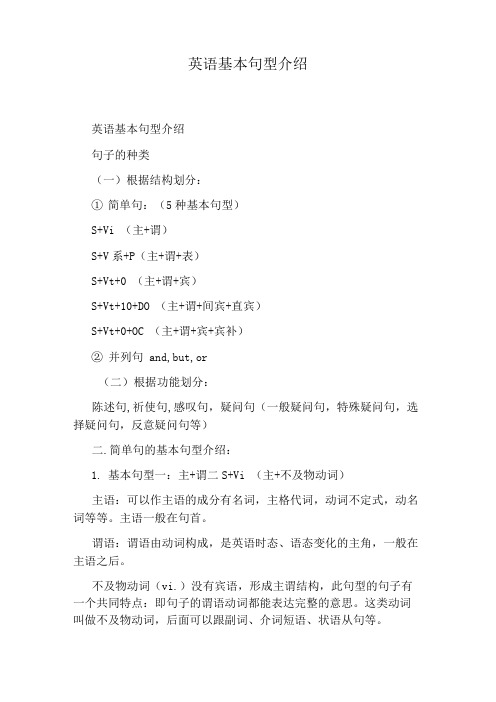
英语基本句型介绍英语基本句型介绍句子的种类(一)根据结构划分:①简单句:(5种基本句型)S+Vi (主+谓)S+V系+P(主+谓+表)S+Vt+0 (主+谓+宾)S+Vt+10+DO (主+谓+间宾+直宾)S+Vt+0+OC (主+谓+宾+宾补)②并列句 and,but,or(二)根据功能划分:陈述句,祈使句,感叹句,疑问句(一般疑问句,特殊疑问句,选择疑问句,反意疑问句等)二.简单句的基本句型介绍:1.基本句型一:主+谓二S+Vi (主+不及物动词)主语:可以作主语的成分有名词,主格代词,动词不定式,动名词等等。
主语一般在句首。
谓语:谓语由动词构成,是英语时态、语态变化的主角,一般在主语之后。
不及物动词(vi.)没有宾语,形成主谓结构,此句型的句子有一个共同特点:即句子的谓语动词都能表达完整的意思。
这类动词叫做不及物动词,后面可以跟副词、介词短语、状语从句等。
2.基本句型二:S+ V系+P(主+系+表)此句型的句子有一个共同的'特点:句子谓语动词都不能表达一个完整的意思,必须加上一个表明主语身份或状态的表语构成复合谓语,才能表达完整的意思。
这类动词叫做连系动词。
3.基本句型三:S+ Vt +0 (主+及物+宾)此句型句子的共同特点是:谓语动词都具有实义,都是主语产生的动作,但不能表达完整的意思,必须跟有一个宾语,即动作的承受者,才能使意思完整。
这类动词叫做及物动词。
4.基本句型四:S+ Vt+I0+D0 (主+及物+间宾+直宾)有些及物动词可以有两个宾语,这两个宾语通常一个指人(间接宾语);一个指物(直接宾语)。
5.基本句型五:S+V t+0 + 0C(主+及物+宾+宾补)此句型的句子的共同特点是:动词虽然是及物动词,但是只跟一个宾语还不能表达完整的意思,必须加上一个补充成分来补足宾语才能使意思完整。
宾语补足语:位于宾语之后对宾语作出说明的成分。
可以用作宾语补足语的有:名词,形容词,不定式,动名词,分词,介词短语。
英语句子的种类

Does he love her.
Tom has done his work. Has Tom done his work. Tom can ride bike. Can Tom ride bike.
1. 2.
1. 2.
陈述句如何变特殊疑问句
1. 2. 3. 4. 5.
or, otherwise ,either…or
3.复合句:主句+从句 主句是一个完整的句子(independent sentence),它可以独立存在。
从句是一个不完整的句子,它必须和一个 主句连用,不能独立存在.
在复合句中,主要包含以下类型从句: 1.主语从句 2.宾语从句
3.表语从句
5.状语从句
2.并列句(compound sentence):
把两个几个简单句
用并列连词连接起来, 则成为一个并列句。
常用并列连词
平行并列连词:
转折并列连词:
因果并列连词: 选择并列连词:
and, both…and, not only… but also, neither…nor but, however, while, yet, when for, so, therefore
6.
结尾将“. ”变成“?”。
注:涉及到第一人称和第二人称时,疑问句中的人称应与陈述句的人称相反。 对主语进行提问直接将疑问词替代主语,对谓语提问时将谓语动词变为do
陈述句如何变一般疑问句
1.
2. 3.
He loves her.
Whom do he loves?
插入
Whom does he love.
确定提问部分所对应的疑问词,将该部分替代为疑问词放在句首; 查看陈述句中是否有情态动词,如果有将情态动词移到疑问词的后面; 查看陈述句中是否有助动词,如果有将情助动词移到疑问词的后面;
英语句子种类与类型

2、疑问句 (Interrogative sentence)
I
有一般疑问句、特殊疑问句、选择疑问句、
反义疑问句。
、 句
1)一般疑问句 (General Questions)
子 种
以情态动词,助动词或系动词Be开头的疑问句。 类
用来询问一件事,答案通常是yes或 no,注意语序。
句 子
7、目的(so that,in order that,in case) ;
类 型
8、条件(if,unless) ;
9、让步(though,although,even if,even though,in spite of the fact that ,whenever,wherever,whoever,whichever,
However,no matter how,whether) 。
3、复合句
并列复合句 即并列连词连接了带
从句的并列句。
二
、
English is widely used in the world, but China 句
has the largest number of people who speak 子
The man dressed in black seems to be a spy.
2、并列句 包含两个或更多互不依从的主谓
结构,分句由并列连词and,then,but,or,or
else,so,for,while,when;both…and,either
…or,neither…nor,not only…,but also,as
用来表达命令、要求、请求、劝告等。说话的对象 是第二人称时,you经常被省略。句末用句号或者叹号。
英语句型讲解
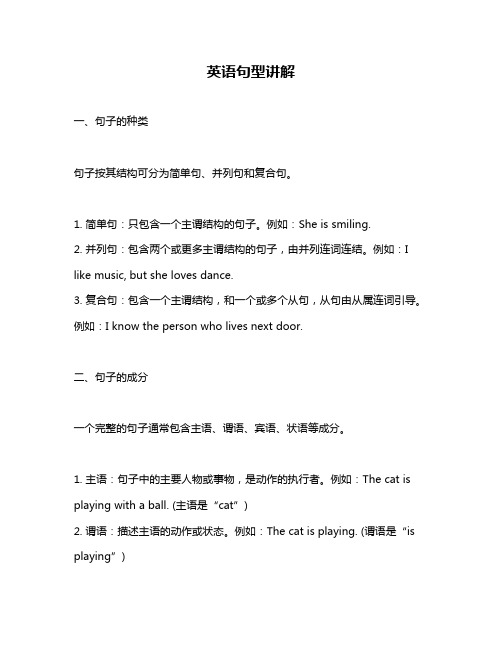
英语句型讲解一、句子的种类句子按其结构可分为简单句、并列句和复合句。
1. 简单句:只包含一个主谓结构的句子。
例如:She is smiling.2. 并列句:包含两个或更多主谓结构的句子,由并列连词连结。
例如:I like music, but she loves dance.3. 复合句:包含一个主谓结构,和一个或多个从句,从句由从属连词引导。
例如:I know the person who lives next door.二、句子的成分一个完整的句子通常包含主语、谓语、宾语、状语等成分。
1. 主语:句子中的主要人物或事物,是动作的执行者。
例如:The cat is playing with a ball. (主语是“cat”)2. 谓语:描述主语的动作或状态。
例如:The cat is playing. (谓语是“is playing”)3. 宾语:动作的承受者。
例如:I love reading books. (宾语是“reading books”)4. 状语:用于修饰动词、形容词或副词,表示时间、地点、方式等。
例如:She sings beautifully. (状语是“beautifully”)三、句型转换1. 肯定句与否定句的转换:在否定句中,通常使用否定词“not”或“no”,有时也使用“never”、“hardly”等否定意义的副词或形容词。
例如:She is not a student. (否定句)2. 陈述句与疑问句的转换:疑问句分为一般疑问句和特殊疑问句。
一般疑问句通常以“do”、“does”、“did”等助动词开头,特殊疑问句则以疑问词开头。
例如:Do you like music? (一般疑问句)3. 主动语态与被动语态的转换:被动语态的结构通常是“be + 过去分词”,其中“be”可以是“am”、“is”、“are”、“was”、“were”。
例如:The book was written by him. (被动语态)4. 倒装句型:将句子中的谓语提前到主语之前,称为倒装句型。
初中英语句子种类讲解(PPT52张)

newspaper when I
came in. ❖She is the girl who
sings best of all.
定语从 句
❖It is well-known that the 2008 Olympic Games will be held on August 8th.
主语从句
❖As is known to all, the
neither…. nor…. ▪ 转折并列连词: but,while,yet
▪ 因果并列连词: for, so
▪ 选择并列连词: or
请用合适的并列连词把每组句子合
并为一个并列句。 1.He was tired. He went to bed.
He was tired, so he went to bed.
<2>. Do you know what w\as
happened yesterday? (改错)
3. _主__语___+__谓__语__+__宾__语___(_S_+V+O)
We are having an English class.
Mr Wang will attend the lecture.
★高考经常考查的系动词:
<1>. “变得”g_e_t____b,e_c_o__m_e__,
_t_u_r_n___, _g_o_____, _g_r_o_w_...
<2>. “看起来”lo_o__k___s,_e_e_m___,_a_p_p__e_ar “闻起来”s_m__e_ll__ “尝起来”taste
感叹句结构
感叹句通常有what, how引导,表示赞美、惊
英语句子四个种类

英语句子四个种类一,简单句(simple sentence)简单句只由一个独立子句构成,它至少包含一个主语和一个动词。
它还可以包含宾语和修饰词。
例句:Birds fly.Studies serve for delight, for ornament, and for ability.二,复合句(compound sentence)复合句由至少两个独立子句构成,中间由连接词构成,也可以由分号、冒号、破折号连接。
连接词包括:Only two things are infinite, the universe and human stupidity, and I'm not sure about the former.三,复杂句(complex sentence)复杂句由一个独立子句以及至少一个从属子句构成,它们之间由连词连接。
在复杂句中,从属子句往往是对独立子句起到一个解释说明的作用,告诉读者更多的信息。
它或是表现出一种因果关系,或是表现在时间或者空间上的关系。
四,复合复杂句(compound-complex sentence)复合复杂句由至少两个独立子句和至少一个从属子句构成,子句和子句之间用连接词相连。
例句:(黑体部份为两个独立子句,斜体部份为从属子句。
)Kate doesn’t like cartoons because they are loud, so she doesn’t watch them. The cat jumped onto the couch and sat down on top of the remote control just when I was reaching for it.。
英语语法∶句子的种类
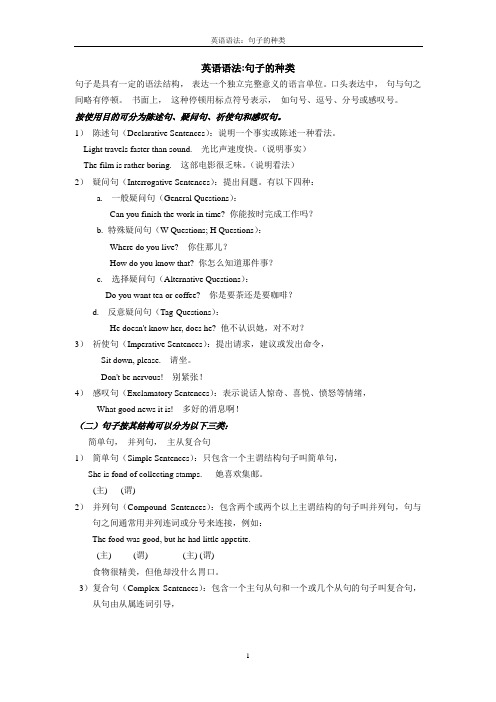
英语语法:句子的种类句子是具有一定的语法结构,表达一个独立完整意义的语言单位。
口头表达中,句与句之间略有停顿。
书面上,这种停顿用标点符号表示,如句号、逗号、分号或感叹号。
按使用目的可分为陈述句、疑问句、祈使句和感叹句。
1)陈述句(Declarative Sentences):说明一个事实或陈述一种看法。
Light travels faster than sound.光比声速度快。
(说明事实)The film is rather boring.这部电影很乏味。
(说明看法)2)疑问句(Interrogative Sentences):提出问题。
有以下四种:a.一般疑问句(General Questions):Can you finish the work in time? 你能按时完成工作吗?b. 特殊疑问句(W Questions; H Questions):Where do you live?你住那儿?How do you know that? 你怎么知道那件事?c.选择疑问句(Alternative Questions):Do you want tea or coffee? 你是要茶还是要咖啡?d.反意疑问句(Tag-Questions):He doesn't know her, does he? 他不认识她,对不对?3)祈使句(Imperative Sentences):提出请求,建议或发出命令,Sit down, please.请坐。
Don't be nervous!别紧张!4)感叹句(Exclamatory Sentences):表示说话人惊奇、喜悦、愤怒等情绪,What good news it is!多好的消息啊!(二)句子按其结构可以分为以下三类:简单句,并列句,主从复合句1)简单句(Simple Sentences):只包含一个主谓结构句子叫简单句,She is fond of collecting stamps.她喜欢集邮。
英语句子按功能分类讲解

疑问部分
don’t _____ they ? • Everyone knows this , _____ did they • No one came , _______ _______? haven’t_____? they • Each of the boys has a football, ______ is it • None of the milk is left, ___ _____?
C) 选择疑问句(Alternative Question) 选择疑问句可以对句子中的任何成分设置选择问题,选择 部分由连词or连接。它貌似一般疑问句,其实两者有区别, 因为回答这种文句时既不能用"Yes"也不能用"No",而是 需要回答人说出具体的选择。另外,连词or之前的部分读 升调,其后的部分读降调。例如: --Is your sister or brother going abroad ? --My brother is . (选择主语)--是你的妹妹还是弟弟要出国?--我弟弟。 --Are you going to school or back home . --(I'm)Going home . (选择谓语) --你是去学校还是回家。--我回家。
These are books,are they?
something everything等 somebody everyone等
it
Nothing is serious, is it ? Everyone knows this,don’t they?/ doesn’t he?
they/he
陈述部分
4) 感叹句(Exclamatory Sentence) 感叹句表示说话人的喜悦、气愤、惊讶等强烈的情绪。 这类句子中,有很多是由What或How引起的。What 用来强调名词,How则强调形容词、副词或动词。这 类句子的构成只需将所强调或是说,所感叹的对象放 到句首;句子无需倒装,句子要用正常语序。 当然, 如果不用这种句型,而句子(无论是那种句子)本身 又表示了上述的种种情绪,那么该句也就成了感叹句。 例如: What a fine day it is today ! How fine it is today ! What a lovely son you have ! How lovely your son is !
英语句子种类

句子一.英语句子种类与类型I、句子种类(按交际用途分)陈述句、疑问句、祈使句、感叹句、There-be存在句II、句子类型(按句子结构分)简单句、并列句、复合句、并列复合句二.句子类型详解1、陈述句说明一个事实或陈述一个看法,有肯定式和否定式,语序是主语在前,位于在后。
She arrived early.(肯定式:陈述事实)She cannot have arrived now.(否定式:陈述事实)The movie is rather boring.(说明看法)否定式:在助动词、情态动词后面+not.(注意含实义动词的句子变成否定句要根据具体情况借助助动词或者情态动词。
)注:1)半否定句I hardly know anything about it.(hardly几乎不)2)部分否定句与全否定句I don’t like both the films.I like neither Cathy nor Mary.3)否定转移I don’t think it will be very cold today.(believe, expect, suppose,imagine这些词用于否定时,都要否定转移)2、疑问句有一般疑问句、特殊疑问句、选择疑问句、反义疑问句。
1.一般疑问句用来询问一件事,答案通常是yes或no,注意语序。
含be动词的一般疑问句,其结构为:be + 主语+ 其它部分?1)Is this your English book?Yes,it is.No,it isn`t.2)Are these your English books?Yes,they are.No,they aren’t.2.含情态动词的一般疑问句,其结构为:情态动词+ 主语+ 动词原形+ 其它部分?(can must might may need等)Can you speak English?肯答:Yes,I can.否答:No,I can’t补充:情态动词,在英文中主要用来表示说话人的看法、态度等。
英语句子结构分析

(数词)
He is asleep.
(形容)
His father is in.
(副词)
The picture is on the wall.
(介词短语)
My watch is gone / missing / lost. (形容词化的 分词)
The question is whether they will come. (表语 从句)
❖e.g. He was a little man with thick glasses, but he had a strange way of making his classes lively and interesting.
❖ 4、表示因果关系,常用的连词有so, for等。
❖e.g. August is the time of the year for rice harvest, so every day I work from dawn until dark.
comes. A. get B. longer C. days D. summer ③ Do you usually go to school by bus?
A. Do B. usually C. go D. bus ④ There will be a meeting at the library this afternoon.
7. He was fond of drawing when he was yet a child. 复合句
8. My brother and I go to school at
half past seven in the morning and
come back home at seven in the
- 1、下载文档前请自行甄别文档内容的完整性,平台不提供额外的编辑、内容补充、找答案等附加服务。
- 2、"仅部分预览"的文档,不可在线预览部分如存在完整性等问题,可反馈申请退款(可完整预览的文档不适用该条件!)。
- 3、如文档侵犯您的权益,请联系客服反馈,我们会尽快为您处理(人工客服工作时间:9:00-18:30)。
Our school has taken (× ) place great changes in the last few years.
3. _____________________ 主语 + 谓语 + 宾语 (S+V+O) We are having an English class. Mr Wang will attend the lecture. 4. ________________________ 主语 +谓语+间宾+直宾 (S+V+O1+O2) I teach you English. He offered me his seat. 5. ________________________ 主语+谓语+宾语+宾补 (S+V+O+C) We should keep our classroom clean and tidy. I heard them cheering in the next room. I saw the window brSummer is coming. S+Vi 2.They won’t let me go. S+V+O+C 3.He showed me a new TV S+V+O1+O2 set. 4.She knows French. S+V+O 5.The gas smells terrible. S+V+P
因果并列连词:
for, or
so
选择并列连词:
请用合适的并列连词把每组句子合 并为一个并列句。 1.He was tired. He went to bed.
He was tired, so he went to bed.
2.The dress is really beautiful. I can’t afford it.
主语 + 谓语 (S + V) 2. ________________ Our chalk has run out. On hearing the news, he cheered. ★高考经常考查的不及物动词(或短 语): happen occur “发生” __________; take place __________; come about __________ break out ; __________ __________ run out give out “用完,用光”________; ________..... 宾语 被动语态 ★不及物动词的用法:
(二)并列句(compound sentence):
把两个或几个简单句用
并列连词或分号连
接起来,则成为一个并列 句。
常用并列连词
and, both….and…., not only…. but also…., 平行并列连词: neither…. nor…. 转折并列连词: but,while,yet
4.He works hard. He also likes helping others. 1>. He not only works hard but he also likes helping others.
2>.Not only does he work hard but he also likes helping others.
The dress is really beautiful, but I can’t afford it.
3. Mary is cooking. John is greeting guests. Mary is cooking ,and / while John is greeting guests.
look seem appear <2>. “看起来” ______,______,______ taste smell “闻起来” ______ “尝起来” _____ feel sound “摸起来” ______ “听起
★系动词的用法:
(注意三点) adj. +___________ 作表语; 宾语 无 __________; 被动语态 无 __________; e.g. The dish ________________. tastes delicious (尝起来好吃) The story _______________. sounds interesting (听起来有趣).
简单句的 五种基本句型
1. _________________________ 主语+系动词+表语 (S+V+P)
It is getting warmer and warmer. He looks pretty happy today. ★高考经常考查的系动词: <1>. “变得” get ______, _______, become turn go grow _______, _______, _____...
英语句子种类
按句子的结构分为三种:
简单句 (simple sentence)
并列句 (compound sentence)
复合句 (complex sentence)
(一).简单句:
只有一个主语(或并列主语) 和 一个谓语(或并列谓语): <1>.Tom likes rock music. <2>.Tom and John are fond of ▲ rock music. <3>.Tom sat down at his desk and began to do his homework. ▲
无 __________, 无_________
e.g. <1>.“过去的几年里我们学校发生了
很大的变化”
Great changes have taken place ____________________________ ____________________________. in our school in the last few years. <2>. Do you know what was \
